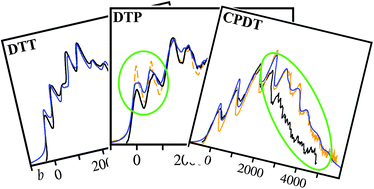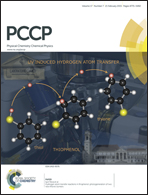The lowest triplet states of bridged cis-2,2′-bithiophenes – theory vs. experiment†
Abstract
Theoretical methods that were previously used to give a good quantitative description of the 31Bu state of trans-2,2′-bithiophene are applied to characterize the lowest triplet states of three bridged cis-2,2′-bithiophenes: 3,3′-cyclopentadithiophene (CPDT), 3,3′-dithienylpyrrole (DTP), and 3,3′-dithienylthiophene (DTT). By obtaining highly accurate reproductions of the phosphorescence spectra of all three compounds, we rationalize the observed vibronic activity, further explore the performance of the applied theoretical methods, and address the quality of the reported experimental spectra. Over the course of this study we have, first, characterized the changes in the electronic structures between the ground state and the lowest triplet state and, second, expressed the related geometrical differences in terms of the Huang–Rhys factors. The Huang–Rhys factors have then been used to generate theoretical emission spectra with vibronic resolution. The applied procedure has yielded quantitative reproductions of the previously reported experimental phosphorescence spectra of DTT and DTP. The experimental spectrum of CPDT, on the other hand, turned out to be considerably narrower and intensity-deficient in its low energy region when compared with the theoretical results. Our experimental reinvestigation of the CPDT phosphorescence has given a refined spectrum that is significantly wider than the previously reported one, and is in nearly quantitative agreement with the theoretical prediction. This enabled us to attribute the observed discrepancy to an experimental artifact associated with the sensitivity characteristics of the commonly used photomultipliers.



 Please wait while we load your content...
Please wait while we load your content...